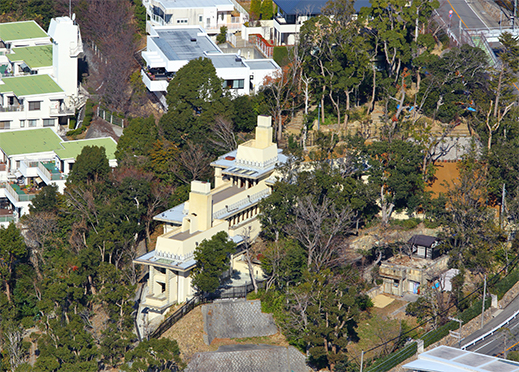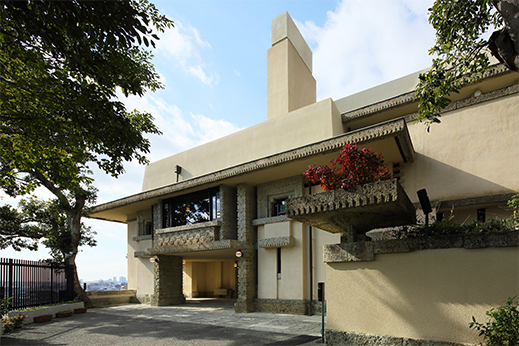 |
Focus features two in-depth reviews each month of fine art, architecture and design exhibitions and events at art museums, galleries and alternative spaces around Japan. The contributors are non-Japanese residents of Japan. |
|
|
 |
 |
 |
Glimpses of Paradise: Yodoko Guest House and Frank Lloyd Wright's Legacy
Colin Smith |
 |
The Yodoko Guest House (Former Yamamura Residence) is one of two surviving Frank Lloyd Wright buildings open to the public in Japan. |
If you're someone who enjoys drooling over real-estate porn on screen or in the newspaper listings, a visit to one of the nicer sections of Ashiya -- an upscale suburb between Kobe and Osaka that's home to spacious modernist houses with sweeping views in leafy surroundings -- is like a nonstop XXX-rated peepshow. The usual mix of admiration and covetousness is transcended, however, at the Yodoko Guest House (a.k.a. the Former Yamamura Residence, as the street sign on the way from Hankyu Ashiyagawa Station has it), a villa designed by Frank Lloyd Wright a few minutes' walk from that station. The first reinforced-concrete structure designated a National Important Cultural Property, it is open to the public on Wednesdays, weekends, and holidays, and strolling through its rooms and gazing from its windows is pure aesthetic delight (OK, there's still a bit of the "Gee, I wish I lived here" factor).
 |
|
Nestled amid trees and designed to blend into the terrain, the structure is hardly noticeable from the nearby road. |
Wright, often called the greatest American architect, drew inspiration from Japan for his philosophy of "organic architecture," according to which buildings developed out of and were integrated into their natural surroundings. Having long admired Japanese prints, he first visited the country in 1905, touring and photographing traditional buildings and gardens. Their functional simplicity, exquisite craftsmanship, and incorporation of exterior into interior -- and of beauty into everyday life -- significantly shaped his development. The crown jewel of his work in Japan, the Tokyo Imperial Hotel, withstood the Great Kanto Earthquake soon after its completion in 1923 with flying colors, but aged and was demolished in 1968 (a section of the lobby was preserved and can be viewed at Meiji-mura, an open-air architectural museum and theme park near Nagoya). Only two of his six realized projects here survive, the Jiyu Gakuen Girls' School in Tokyo (co-designed with Arata Endo) and the Yodoko Guest House. The latter, designed in 1918 for a family of Nada, Kobe sake brewers, also fell deeply into disrepair but escaped the hotel's fate thanks to extensive and meticulous renovations.
 |
|
Decorative elements are made of the same porous volcanic Oya stone used in the no longer existent Tokyo Imperial Hotel. |
The approach to the building is intentionally roundabout, letting you appreciate the exterior of the four-story structure, built in staggered levels against a hillside so that it nestles rather than towers. One is struck first of all by the light, highly porous Oya stone, a volcanic tuff from a quarry near Nikko in Tochigi Prefecture (you can visit the Oya History Museum there and tour an underground mine full of the rock), used liberally throughout the exterior and interior as it was in the Imperial Hotel. Shaped into crenellated geometric formations that resemble the hotel's Mesoamerican-influenced motifs, it has an ancient feel that counterbalances the concrete framework's modernity, as do other materials -- dark wood, verdigris-coated copper, and in some rooms tatami mats (these rooms were largely the work of Wright's Japanese protégés Arata Endo, mentioned above, and Makoto Minami). East and West blend seamlessly, as in the decorative copper-plate ranma transoms in these rooms, and in Wright-designed pyramidal lamps shaded with rice paper.
 |
|
East meets West: Ranma transoms in the Japanese-style rooms have a quintessentially Wrightian design. |
Loving attention to detail is everywhere, as is emphasis on natural light, ventilation, and views to link indoors with outdoors. These principles are embodied in rows of door-like openings along the ceiling, tiny yet flooding the spaces with light, and in seasonal flower and vegetation arrangements in various alcoves and spaces. The minuscule Oya stone fireplace in the children's room is another heartwarming touch.
 |
|
A row of apertures near the ceiling helps keep the drawing room well lit, and the Oya stone fireplace looks like it would have made things cozy. |
After the house was completed in 1924, the Yamamura family only occupied it for about a decade, and its subsequent history was full of twists and turns. After World War II, in 1947, it became the property of its current owner, Yodogawa Steel Works, Ltd., which used it as a home for the company president. It was rented out to Americans during the 1960s, served as company housing for single employees (!) in the early 1970s, then earned the Important Cultural Property designation in 1974, after which 15 years passed before it was fully restored and opened to the public. The house sustained damage again in the Great Hanshin-Awaji Earthquake of 1995 and has twice been closed for major repairs, reopening earlier this year. You would never know it, though: every piece of volcanic stone and wood, every slab of concrete was replaced using the same materials and methods as in 1924. One wonders if the Imperial Hotel too might have been saved, had it survived a few more years into an era when historical preservation was more highly prioritized.
 |
|
Repeated and scrupulous renovations (chronicled in a video playing on-site) have kept this architectural treasure looking good as new. |
If you have time left after touring the Yodoko Guest House, visit nearby Koshien Hall (the former Koshien Hotel), designed by Arata Endo. Completed in 1930, it was known as western Japan's equivalent of the Imperial, and beautifully blends Western-style architecture and Japanese aesthetics. Now a part of Mukogawa Women's University, and also protected as a Tangible Cultural Property, it is one of the largest pieces of Wright-style architecture remaining in Japan and has echoes of the Yodoko Guest House in its geometric reliefs, distinctive volcanic tuff (Nikka stone in this case), and amalgamation of East and West (kawara roof tiles and stupa-like towers on a modern structure emphasizing elongated horizontal blocks). To tour the interior, reservations must be made by fax at least one month in advance.
Koshien Hall, a former hotel, was designed by Arata Endo, a prominent Japanese Wright protégé. |
The Hanshinkan (lit. "between Osaka and Kobe") region, of which Ashiya is part, is home to some of Japan's first garden city-style suburbs, which developed as rail lines extended out into the surrounding countryside. It is synonymous with stylish modernity -- "Hanshinkan Modernism" is an established term encompassing the art, culture, and lifestyle that developed there in the early and mid-20th century. The Yodoko Guest House is a must-see for Frank Lloyd Wright fans, and architecture aficionados in general will find plenty of designs -- often influenced, however indirectly, by Wright's legacy -- to enchant the (possibly slightly envious) eye in this stretch of residential serenity between mountains and sea.
Another view of Koshien Hall. The area between Osaka and Kobe is known for its attractive and eclectic architecture. |
All images courtesy of Yodoko Guest House or Koshien Hall. |
 |
 |
Colin Smith
Colin Smith is a translator and writer and a long-term resident of Osaka. His published writing includes the travel guide Getting Around Kyoto and Nara (Tuttle, 2015), and his translations, primarily on Japanese art, have appeared in From Postwar to Postmodern: Art in Japan 1945-1989: Primary Documents (MoMA Primary Documents, 2012) and many museum and gallery publications in Japan. |
|
 |
|